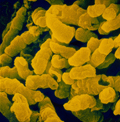 More rarely, Hib is responsible for other life-threatening complications in young children, such as septic arthritis, an inflammation of the joints, and septicaemia, or blood poisoning, both of which also can have other causes. And it may lead to epiglottitis (a life-threatening inflammation of the flexible cartilage that covers the gap in the vocal cords during swallowing).
More rarely, Hib is responsible for other life-threatening complications in young children, such as septic arthritis, an inflammation of the joints, and septicaemia, or blood poisoning, both of which also can have other causes. And it may lead to epiglottitis (a life-threatening inflammation of the flexible cartilage that covers the gap in the vocal cords during swallowing).
While HiB infection can be fatal, it can also leave survivors with permanent disabilities such as mental retardation or deafness.
A highly effective vaccine was developed in the 1990s and is recommended by the World Health Organisation (WHO) “where resources permit” and the burden of disease is established.
(Note: the bacterium does not cause influenza, although its name can cause confusion.)
Click here to read more.
This article is part of a series compiled by Vaccines Today to raise awareness of European Immunization Week 2011 which runs from 23-30 April




